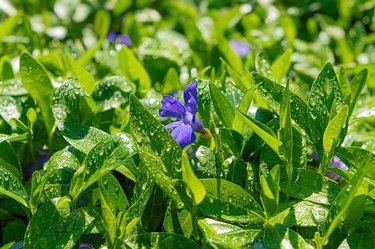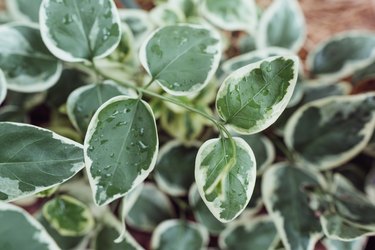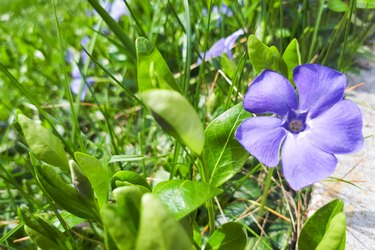
Annual vinca (Catharanthus roseus) is known for producing a riot of blooms from June through to the first frost. It makes an excellent groundcover or filler for beds, and its cultivars offer bloom colors ranging from white, pale pink and lilac to red, rose and hot pink. Vinca leaves turning yellow aren't just an esthetic issue, but a tell-tale sign that the plant is stressed. Identifying and managing the cause can help.
Identifying Your Vinca Plants
Video of the Day
Native to Madagascar, annual vinca is winter hardy to U.S. Department of Agriculture plant hardiness zones 10 and 11, and is therefore, as the name suggests, usually replanted every year. Although there are several plants that are referred to as vinca, including greater periwinkle (Vinca major), hardy to USDA zones 7 through 9 and sometimes invasive, and lesser periwinkle (Vinca minor), hardy to USDA zones 4 through 8, most people think of annual vinca when they speak of vinca flowers. The periwinkles produce small, lavender flowers in spring and summer, but are outclassed by annual vinca's prolific blooms.
Video of the Day
Vinca Leaves Turning Yellow from Rot
Several types of rot may result in vinca or periwinkle leaves turning yellow, or even falling off the plant. Phytophthora nicotianae may cause stem blight and root rot, initially causing yellowing and stunting of leaves, and eventually causing die back or death. Overwatering is a main cause. Because annual vinca is fairly drought tolerant, you should avoid watering unless rainfall is supplying less than an inch a week, in which case you can make up for it by watering once or twice per week. Ensuring good soil drainage also helps.
Yellow Leaves From Leaf Spot

Leaf spot may affect your vinca at the hands of a number of fungal diseases, usually Alternaria alternata and Ulocladium spp., but results either way in the same symptoms. Small spots slowly enlarge, moving from the stem upward to the top of the plant, eventually causing leaves to yellow and drop off. Avoid moistening the leaves for long periods of time or at night by watering in the morning at the base of the plant. Also ensure good soil fertility, which will help plants combat the disease.
Tomato Spotted Wilt Virus
A disease that affects many types of plants differently, tomato spotted wilt virus usually shows up on annual vinca as black concentric ring spots or lines. The leaves will turn yellow and grow in a stunted or distorted fashion. Because there is no cure for this disease, dig up plants and discard them immediately. Avoid planting vinca near vegetables that may harbor the disease, and control weeds.
Infection With Aster Yellows

Caused by bacteria and transmitted by the aster or the six-spotted leafhopper, aster yellows is another disease that can cause leaf yellowing of annual vinca. Ornamental plants that have aster yellows are stunted and yellow, and they have many secondary and malformed shoots instead of fewer, healthy ones. Aster yellows is a difficult disease to get rid of, and plants that contract it should be removed and destroyed immediately to prevent infection of nearby plants. Do not plant vinca next to plants that have the disease.